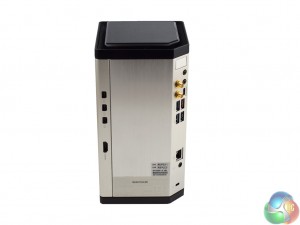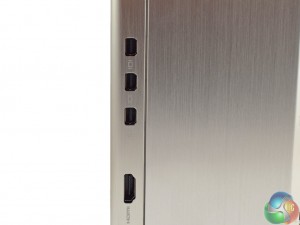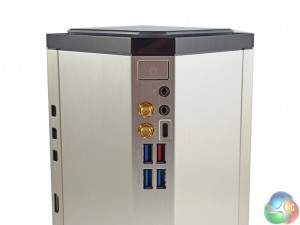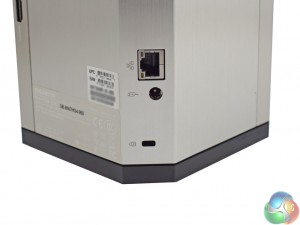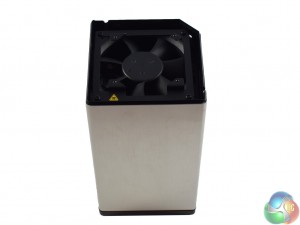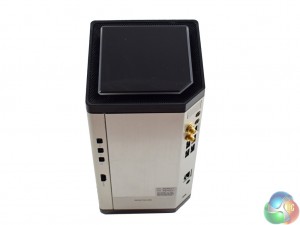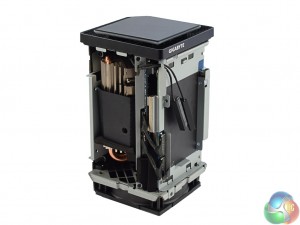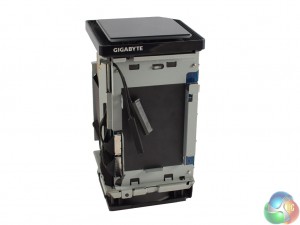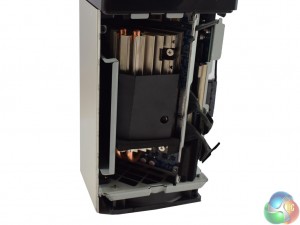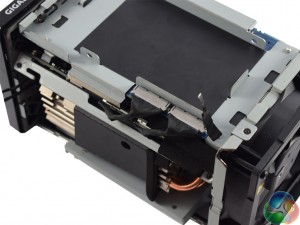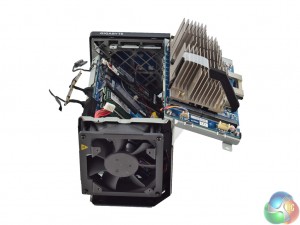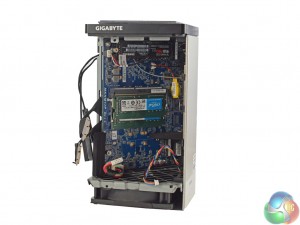Here we get our first look at the BRIX Gaming UHD. Rather than the smaller, NUC-style BRIX devices we have seen before, the BRIX UHD looks more like the Mac Pro or the MSI Vortex G65. Yes, I suppose it does look a bit like a small bin. But a nice bin, to say the least.
The external fascia is brushed aluminium which looks swanky and feels sturdy. It is still very small, too, measuring 220 mm x 110 mm x 110 mm (L x W x D). Slightly larger than a pint glass, to my mind.
The video-out connectors are on the side, with 3x mini DisplayPorts, and just the 1x HDMI 2.0 (4K60 capable).
In the rear corner are the other I/O ports. A good array for such a small device, we find 2x USB 3.1 (one Type-C, one Type-A) as well as 3x USB 3.0. There are also the usual headphone jacks and antenna mounts for the integrated WiFi chip.
At the bottom is an Ethernet port, the power-in socket as well as a Kensington lock.
By now you are probably thinking, ‘well how does that stay cool?'. And the answer is simple, if not immediately obvious. A single fan is positioned at the bottom of the chassis, and it draws air through a mesh panel. That air then exhausts through the top of the device (pictured on the right), which also has a meshed section.
Four screws removes the base panel, allowing access to the 80mm fan. From there, the aluminium fascia slides off with a firm tug – and we see the insides of the machine.
First, I want to point out where 2.5in drives mount. There are two locations, one which is obvious very quickly (pictured on the left). Simply screw in your drive to the metal bracket which is very straightforward. In the picture on the right, you can see a small bracket lodged behind the CPU heatsink. This can also be removed to house a second 2.5in drive.
While I did not receive any mounting screws with my sample of the BRIX UHD, we have been assured by Gigabyte the retail version does include the necessary 2.5in screws.
To get access to the rest of the machine, you must first unplug the power cables from the graphics card (as pictured). After that, there are just two more screws to remove.
Once you have done that, the graphics card can be removed. It is actually installed using a hinge mechanism, which is very clever. You can also see the card itself has only a heatsink on it – the entirety of the active cooling in the BRIX UHD comes from the single intake fan at the bottom of the chassis.
Once the graphics card has been lifted out, you get access to the mainboard. As the BRIX UHD is a barebones system, users must install memory and storage. Gigabyte did this for us, installing a 512GB Samsung 950 PRO, as well as 2x8GB DDR4 2400MHz SODIMMs from Crucial. The BRIX UHD supports up to 32GB of RAM, though the memory only runs at 2133MHz.
There are a total of 3 M.2 ports. One is populated by the WiFi card (under the 950 Pro), while two come empty. The slot populated by the 950 Pro can receive either PCIe or SATA drives, while the last M.2 port (at the other end of the motherboard) is PCIe only.
All-in-all, I think that is pretty good going for such a small device. The BRIX UHD has the ability to house 2x M.2 drives, as well as 2x 2.5in drives – which could mean terabytes of flash and mechanical storage space, all in the tiny chassis.
 KitGuru KitGuru.net – Tech News | Hardware News | Hardware Reviews | IOS | Mobile | Gaming | Graphics Cards
KitGuru KitGuru.net – Tech News | Hardware News | Hardware Reviews | IOS | Mobile | Gaming | Graphics Cards



